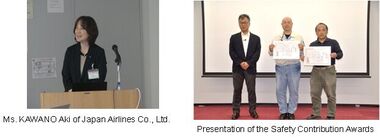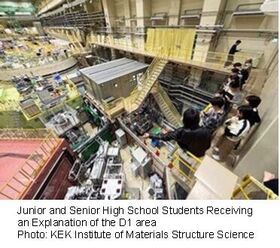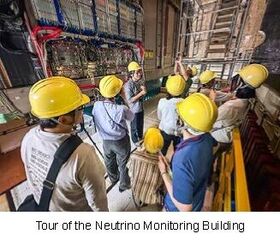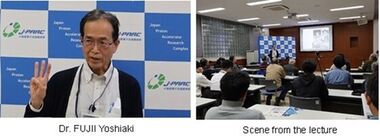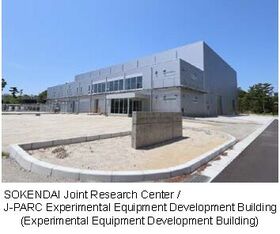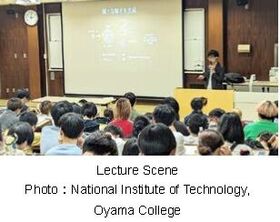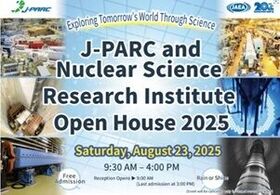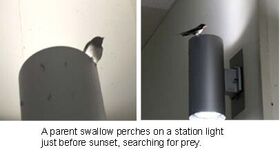J-PARC News June 2025 (Issue #242)
■Press Release
Successful Observation of a New Atomic System: Multicharged Muonic Ions
— Exploring the Exotic World of Atoms Captured by Space Observation Detectors — (June 19)
When multiple electrons leave an atom, it forms a highly positively charged ion known as a multicharged ion. In the case of multicharged muonic ions, where both electrons and a negative muon are simultaneously bound to the nucleus, suppressing charge transfer reactions from surrounding atoms is essential. To this end, it is essential to use low-pressure gas targets with low atomic number densities. However, such conditions inevitably reduce the production yield of multicharged muonic ions.
To overcome this challenge, researchers used low-energy muons at the Muon D2 beamline of the Muon Science Facility (MLF) to enhance the production of multicharged muonic ions. Additionally, a superconducting transition-edge sensor (TES) microcalorimeter — originally developed for high-precision spectroscopy in applications such as space X-ray observations — was introduced to precisely measure the characteristic X-ray energies emitted by these ions. As a result, for the first time, researchers successfully identified and observed both the number of electrons bound to multicharged muonic ions and their quantum states.
Multicharged muonic ions represent a completely new class of atoms and are of great interest from a fundamental science perspective. Furthermore, the high-precision spectroscopy techniques established through this research are expected to open new avenues for the application of negative muons.
For more details (available in Japanese only), please visit the J-PARC website:
https://j-parc.jp/c/press-release/2025/06/19001563.html
■Three R&D Projects Proposed by KEK Selected for the Key and Advanced Technology R&D through Cross Community Collaboration Program (June 13)
Three research and development projects proposed by the High Energy Accelerator Research Organization (KEK), focusing on structural imaging technologies using particles called muons, have been selected for the Key and Advanced Technology R&D through Cross Community Collaboration Program. The program period runs from August 2024 to July 31, 2029. The selected projects are as follows:
- 1. Development of visualization technology for elemental distribution using characteristic muon X-rays
2. Ultra-high resolution elemental analysis using cosmic-ray muons and superconducting transition-edge sensor (TES) microcalorimeters
3. Development of core technology for compact, high-intensity artificial muon generation
For more details (available in Japanese only), please visit the J-PARC website:
https://j-parc.jp/c/press-release/2025/06/13001555.html
■J-PARC Safety Day (May 23)
On May 23, 2013, a radioactive material leakage incident occurred at the Hadron Experimental Facility, causing concern and inconvenience to members of the local community and all those involved. In response, J-PARC has designated this time of year as “J-PARC Safety Day” to reflect on safety.
This year, 374 staff members participated in the event in a hybrid format. In the morning session, each section shared fire prevention efforts during a safety information exchange meeting. In the afternoon, we held a workshop on fostering a safety culture, beginning with the presentation of the Safety Contribution Award.
Following the session, the invited talk “Safety Management of In-Flight Meals: Reducing Invisible Risks” was given by Ms. KAWANO Aki, Mr. FUJIO Tomohiro, and Mr. IWAMOTO Masaharu from the Japan Airlines Co., Ltd. Their presentation highlighted the importance of swift and accurate operations to ensure safe meals in the confined environment of an aircraft and included specific examples.
Finally, the documentary video “The Radioactive Material Leak Incident at J-PARC, focusing on the Scientific Aspects” was screened.
J-PARC will continue to hold this event annually to ensure that all staff members prioritize safety in their research activities and prevent such an incident from happening again.
■Junior and Senior High School Students Take on Muon Beam Experiments at J-PARC (May 5–6)
Four junior and senior high school students, supported by the inquiry-based learning program of Accel Kitchen LLC, conducted muon beam experiments at the Muon D1 beamline of the Materials and Life Science Experimental Facility (MLF) at J-PARC. This marks the first time that students of this age group have performed beam experiments at J-PARC.
MATSUSHITA Chiori from Joshigakuin High School, a member of the Sakura Particles team that became the first Japanese high school students to conduct beam experiments at CERN in 2024, carried out further verification using a two-dimensional beam monitor that had previously been evaluated at CERN. KAWAMICHI Kanon and ASANO Sora from Nagoya University Affiliated Upper and Lower Secondary Schools explored the speed of cosmic-ray muons using the Time of Flight (TOF) method. They measured the time difference of muon arrivals by adjusting the distance between two detectors placed one behind the other on the beamline.
AONO Mayu from Tokyo Gakugei University Senior High School, who has been investigating the thickness of school ceilings using cosmic rays through Accel Kitchen, prepared her concrete sample and conducted a beam experiment by placing detectors before and after the sample.
For more details (available in Japanese only), visit the J-PARC website.
(J-PARC HP)https://j-parc.jp/c/press-release/2025/05/23001516.html
■Press Tour of J-PARC and KEK Facilities (June 16)
A press tour titled “The Hyper-Kamiokande Project So Far: The History and Latest Information on Neutrino Experiments from the Beam Source Side” was held for media representatives. This event welcomed not only major newspapers and TV stations but also freelance writers, photographers, and science-focused YouTubers, drawing a diverse group of 25 participants.
In the morning, the group visited KEK in Tsukuba City, where they toured the remnants of the world’s first long-baseline neutrino oscillation experiment (K2K), including the neutrino beamline and the water Cherenkov-type near detector. In the afternoon, at the J-PARC Neutrino Monitor Building, participants observed the underground off-axis detector and INGRID (the on-axis detector) up close. Notably, the off-axis detector was undergoing maintenance, allowing visitors a rare view of the open electromagnets and newly installed observation equipment. The tour also included a visit to the construction site of the intermediate water Cherenkov detector for the Hyper-Kamiokande project in Tokai Village.
The event was widely covered by media across the county, reaffirming the significant public interest in neutrino oscillation experiments.
■Hello Science: "Exploring Ancient Mysteries with Muons from the Sky" (May 30)
Dr. FUJII Yoshiaki from the Particle and Nuclear Physics Division introduced a project using muons to investigate the interior of ancient burial mounds, titled the“Muographic Investigation of Ancient Burial Mounds in Tokai.”
Funatsuka Tumulus Group No. 2, a designated cultural property in Tokai Village, is believed to be the tomb of an influential figure from the 6th century. However, its internal structure remains a mystery. To uncover this, a project began two years ago to use cosmic ray muons to non-destructively visualize the inside of the mound and search for a stone chamber. This interdisciplinary project, led by students from elementary to high school, is considered rare even on a global scale and has attracted attention from numerous media outlets.
The students received lectures from experts in various fields, including archaeology, local history, radiation, elementary particles, and the principle of the detector. They then assembled a muon detector with their own hands. After identifying potential detector installation sites on maps and confirming them on location, the students installed the detector at the site deemed optimal in October of last year. While the analysis results are still forthcoming, the project sparks curiosity about potential discoveries.
Dr. FUJII expressed his hopes for the project, saying, “I hope children will develop an interest in their local heritage while also discovering the joy of science. It would be wonderful if they grow up with a love for both science and history.”
■Experimental Equipment Development Building Tour (June 2)
A tour of the newly completed SOKENDAI Joint Research Center / J-PARC Experimental Equipment Development Building was held on June 2, with special guests President NAGATA Takashi and Vice President YAMAMOTO Satoshi of the Graduate University for Advanced Studies (SOKENDAI).
For more details (available in Japanese only), please visit the KEK website:
https://www.kek.jp/ja/topics/202506181700sokendai
■J-PARC Outreach Lecture at National Institute of Technology, Oyama College (June 10)
A special lecture titled “How Accelerators Reveal the Microscopic World: Muon Acceleration Technology for Probing from Particle Phenomena to Massive Structures” was presented to 130 second and third-year students at the National Institute of Technology, Oyama College. The event was part of a community collaboration project focused on the student-led development of a compact accelerator named AxeLatoon—a term that combines “Accelerator” and “Ratoon” (meaning a new sprout). Dr. OTANI Masashi from the Accelerator Division delivered the lecture.
During the presentation, he explained the principles of particle accelerators and their diverse applications in industries such as medicine and research. Dr. OTANI also introduced cutting-edge research at J-PARC, which involves the use of artificially generated muons. He discussed recent technological advancements and future research directions in the field.
In post-event surveys, students shared their thoughts: “I want to hear more about practical applications of accelerators,” “I’m curious about future uses of accelerator technology,” and “It was great to learn about the research at KEK and J-PARC, as well as what life is like at a research institute—something we don’t usually hear about.”
■Announcement: J-PARC and Nuclear Science Research Institute Open House 2025 (August 23)
On Saturday, August 23, J-PARC and the Nuclear Science Research Institute will jointly host their annual open house, themed “Exploring Tomorrow’s World Through Science.” Visitors will have a unique opportunity to tour experimental facilities and accelerators that are usually closed to the public (some tours require reservations). The event will also feature a science café, hands-on experiment workshops and food trucks. We warmly invite you to join us!
For more details, please visit the J-PARC and Nuclear Science Research Institute Open House 2025 Special Website.
https://j-parc.jp/OPEN_HOUSE/2025/index_e.html
■J-PARC Sanpomichi 59

Every year, swallows arrive from southern lands at JR Tokai Station, the nearest station to J-PARC. Unlike many other migratory birds, swallows travel alone, crossing thousands of kilometers of ocean. When catching insects or escaping predators like raptors, they can fly at speeds close to 200 km/h. A swallow weighs only about 20 grams—less than the weight of three 500-yen coins. From a human perspective, it's astonishing that such a small creature possesses such endurance and explosive power.
Similarly, the neutrinos artificially produced at J-PARC, are tiny particles that also travel at the speed of light. Most of these neutrinos pass through the massive water tank of Super-Kamiokande, located 295 km away, and continue their journey into outer space.
As the intense summer heat sets in, perhaps it's not such a bad idea to reflect on these tiny travelers and the vast world they inhabit.

